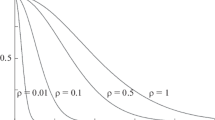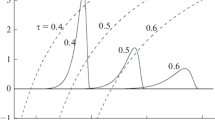Abstract
The ground level event of November 18, 1968, was unusual in that pronounced anisotropy persisted essentially until the cessation of the arrival at the earth of relativistic protons. Real and significant differences were observed in the intensity profiles at different neutron monitor stations. By a method of successive approximations, the geographical coordinates of the axis of symmetry were determined as: latitude λ = - 25° ± 10° and longitude φ = -35° ± 10°. The exponent in a power law spectral representation over the narrow range covered by the nucleonic intensity measurements was υ ≈ 5.
The onset times of the GLE were related to the angular differences between the mean directions of viewing and the axis of symmetry. The event differed markedly from earlier isotropic events that were well described by diffusion theory, but was compatible with the predictions of a model envisaging diffusion only in the vicinity of the Sun (radius R of solar envelope ≈ 34 solar radii). The diffusion coefficient D ≈ 3 × 1021 cm2/s is consistent with that deduced for earlier isotropic events, but the values of other parameters are smaller than those derived for the only previously observed event to which the model of diffusion in an inhomogeneous medium was applicable (May 4, 1960).
It is concluded that the observed one hundred percent anisotropy was a direct consequence of the propagation mechanism rather than other postulated causes. Furthermore, the observed large pitchangle distribution was produced by scattering from small scale field irregularities.
Similar content being viewed by others
References
Baird, G. A., Bell, G. G., Duggal, S. P., and Pomerantz, M. A.: 1967, Solar Phys. 2, 491.
Bukata, R. P., Gronstal, P. T., Palmeira, R. A. R., McCracken, K. G., and Rao, U. R.: 1969, Solar Phys. 10, 198.
Burlaga, L. F.: 1970, Acta Phys. Hungaricae 2, 9.
Duggal, S. P. and Pomerantz, M. A.: 1971a, to be published.
Gall, R.: 1968, J. Geophys. Res. 73, 4400.
Lockwood, J. A.: 1968, J. Geophys. Res. 73, 4247.
Mathews, T. and Wilson, B. G.: 1970, Acta Physica Hungaricae 2, 433.
McCracken, K. G.: 1962, J. Geophys. Res. 67, 447.
McCracken, K. G. and Rao, U. R.: 1970, Space Sci. Rev. 11, 155.
Pinter, S.: 1970, Report UAG 9, World Data Center A, p. 26.
Pomerantz, M. A., Duggal, S. P., and Nagashima, K.: 1961, Space Research II, North Holland Publ. Co., Amsterdam, p. 788.
Shea, M. A. and Smart, D. F.: 1970, private communication.
World Data Center A, Report UAG-9, 1970, compiled by J. Virginia Lincoln, Boulder, Colorado.
Author information
Authors and Affiliations
Additional information
This research was sponsored by the National Science Foundation and Air Force Cambridge Research Laboratories, Office of Aerospace Research, under Contract No. F19628-70-C-0190, but the report does not necessarily reflect endorsement by the sponsor.
Rights and permissions
About this article
Cite this article
Duggal, S.P., Guidi, I. & Pomerantz, M.A. The unusual anisotropic solar particle event of November 18, 1968. Sol Phys 19, 234–246 (1971). https://doi.org/10.1007/BF00148837
Received:
Issue Date:
DOI: https://doi.org/10.1007/BF00148837




